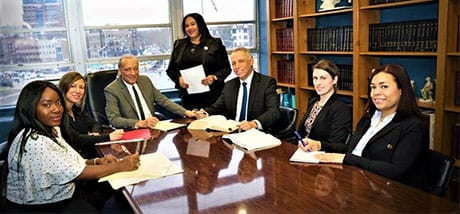Evidence of Fraud – Or a Clue to Murder?

BY: By Robert E. Kessler. STAFF WRITER
A bloody shoe print found next to the body of a Hicksville woman savagely murdered in her home in January looks like it should be a key piece of evidence in a homicide trial rather than a fraud trial. Especially since federal prosecutors say the print matches a shoe, a left brown dress shoe, size 10, of the victim’s estranged husband, a Queens millionaire, from whom she was seeking a divorce partly on the grounds that he was trying to cheat her out of her half of a $1.4-million estate. But because of both a quirk in federal law and the way in which the initial homicide investigation was conducted, the bloody shoe print may help convict the husband of fraud in federal court. If that happens, he may end up with a sentence as harsh as a murder conviction in state court would bring.
The federal court case involves Ali Bessaha, 62, of 43-20 40th St., Long Island City, who is accused of defrauding his late wife, Ourida, 54, out of her share of some of their joint assets in the midst of bitterly contested divorce proceedings. Ourida was found slain by numerous blows from a blunt instrument to her head shortly before a key hearing in the divorce case, according to statements by Assistant U.S. Attorney Gary Brown at a recent pretrial hearing in U.S. District Court in Hauppauge.
Bessaha’s attorney, Todd Greenberg of Forest Hills, said his client is not guilty and neither defrauded nor murdered his wife. Greenberg also argued that to allow evidence of an alleged murder into a simple fraud case would violate his client’s rights to a fair trial and so inflame a jury that his client could not get a fair trial. Greenberg also said that the shoe was a common one and that many men own such a pair. But Brown has been arguing in pretrial motions and at the pretrial hearing before U.S. District Court Judge Leonard Wexler, in what is known as a Mastrangelo hearing, that the federal government should be allowed to introduce evidence that Bessaha killed his wife to support its contention that the husband also defrauded her.
The evidence would include the bloody shoe print, which Brown says has a unique pattern, as well as statements Ourida Bessaha made during the divorce case that her husband had been cheating her and had threatened her with violence. Normally, the statements of a dead person could not be introduced into a trial because it would violate two fundamental tenets of law: the constitutional right under the Sixth Amendment to confront one’s accuser and a rule of court procedure that bars the admission of hearsay statements, defined as statements made outside of court. But there is an exception to this in a Mastrangelo hearing, named after Richard Mastrangelo of Huntington, who was sentenced to nine years in prison in 1982 for smuggling 23 tons of marijuana and a half-million methaqualone tablets from Colombia to Queens.
The main evidence against him was the grand jury testimony of a man who was murdered before he could testify at the smuggling trial. The federal courts have ruled that if the government can show at a pretrial hearing that a defendant was involved in the murder of a key witness, then the witness’ statements can be introduced at a trial. In court papers, Brown quoted both U.S. Supreme Court and federal Appeals Court rulings that state that “neither in criminal nor in civil cases will the law allow a person to take advantage of his own wrong” and “any other result would mock the very system of justice the confrontation clause was designed to protect.” But it is up to a judge to decide whether the murder evidence is too prejudicial to be allowed into a trial, and whether the jury should be allowed to hear the statements made by the defendant’s wife before she was killed.
Judge Wexler has reserved decision. Federal postal inspectors found the shoe matching the bloody shoe print in Bessaha’s Queens home, according to testimony at the Mastrangelo hearing by postal inspector Carl Sclafani. The Nassau district attorney’s office and the Nassau homicide squad had contacted federal officials about evidence they uncovered during the homicide investigation indicating Bessaha was using bank accounts in France and Algeria, but they did not have enough evidence in that investigation to search Bessaha’s house, Sclafani said. Fred Klein, the chief of the district attorney’s Major Offense Bureau, says Bessaha is still the only suspect in his wife’s murder. But a county murder trial may not be necessary if Bessaha is convicted of the federal charges of mail and wire fraud and money laundering.
While the federal sentencing guidelines call for a sentence of 8 years, the judge has the ability to increase the sentence for up to 60 years in a fraud case that involves a murder. The guidelines state that in sentencing “a substantial increase may be appropriate if death was intended É or if the underlying offense was one for which the [minimum sentencing guideline] levels do not reflect an allowance for the risk of personal injury, such as fraud.”
11-10-1999, pp A48.

